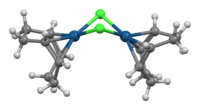
Photo from wikipedia
In this report, we investigate a new family of cationic iridium(III) complexes featuring the cyclometalating ligand 2-phenylbenzimidazole and ancillary ligand 4,4'-dimethyl-2,2'-bipyridine. Our benchmark complex IrL12 (L1 = 2-phenylbenzimidazole) displays emission… Click to show full abstract
In this report, we investigate a new family of cationic iridium(III) complexes featuring the cyclometalating ligand 2-phenylbenzimidazole and ancillary ligand 4,4'-dimethyl-2,2'-bipyridine. Our benchmark complex IrL12 (L1 = 2-phenylbenzimidazole) displays emission properties similar to those of the archetypical complex 2,2'-dipyridylbis(2',4'-phenylpyridine)iridium(III) in deaerated CH3CN (Φ = 0.20, λem = 584 nm and Φ = 0.14, λem = 585 nm, respectively) but exhibits a higher photoluminescence quantum yield in deaerated CH2Cl2 (Φ = 0.32, λem = 566 nm and Φ = 0.20, λem = 595 nm, respectively) and especially a lower nonradiative constant (knr = 6.6 × 105 s-1 vs knr = 1.4 × 106 s-1, respectively). As a primary investigation, we explored the influence of the introduction of electron-donating and electron-withdrawing groups on the benzimidazole moiety and the synergetic effect of the substitution of the cyclometalating phenyl moiety at the para position with the same substituents. The emission energy displays very good correlation with the Hammett constants of the introduced substituents as well as with ΔEredox values, which allow us to ascribe the phosphorescence of these series to emanate mainly from a mixed metal/ligand to ligand charge transfer triplet excited state (3M/LLCT*). Two complexes (IrL52 and IrL82) display a switch of the lowest triplet excited state from 3M/LLCT* to ligand centered (3LC*), from the less polar CH2Cl2 to the more polar CH3CN. The observed results are supported by (TD)-DFT computations considering the vibrational contributions to the electronic transitions. Chromaticity diagrams based on the maximum emission wavelength of the recorded and simulated phosphorescence spectra demonstrate the strong promise of our complexes as emitting materials, together with the very good agreement between experimental and theoretical results.
Journal Title: Inorganic chemistry
Year Published: 2022
Link to full text (if available)
Share on Social Media: Sign Up to like & get
recommendations!